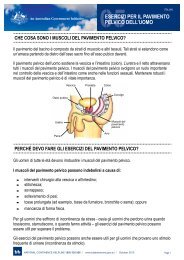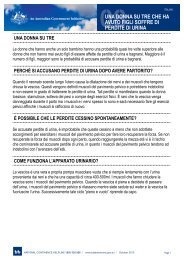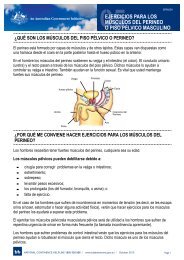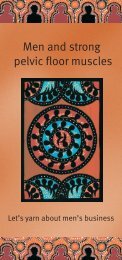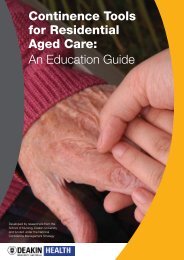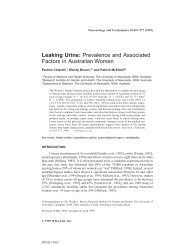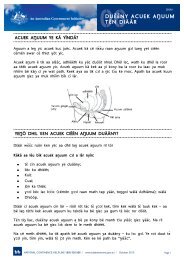Pharmacy Continence Care - Bladder and Bowel Website
Pharmacy Continence Care - Bladder and Bowel Website
Pharmacy Continence Care - Bladder and Bowel Website
You also want an ePaper? Increase the reach of your titles
YUMPU automatically turns print PDFs into web optimized ePapers that Google loves.
2 METHODOLOGY<br />
The methodology for the second stage of the PCCP included the following seven elements<br />
summarised here. Appendix 1 provides further detail.<br />
Element 1 – Project Inception<br />
During this initial phase, members of the project team met with the project manager <strong>and</strong><br />
finalised the project plan.<br />
Element 2 – Desk Research<br />
Members of the project team:<br />
• reviewed <strong>and</strong> refined the <strong>Pharmacy</strong> <strong>Continence</strong> <strong>Care</strong> Program module developed in Stage<br />
1 of the Project<br />
• conducted a review of the commissioned literature review on incontinence (see Appendix<br />
4)<br />
• reviewed the results <strong>and</strong> findings of the Hunter <strong>Continence</strong> Awareness project<br />
• reviewed other relevant literature, materials <strong>and</strong> programs<br />
• consulted stakeholders by telephone or face-to-face interview, using a semi-structured<br />
interview schedule<br />
• reviewed <strong>and</strong> refined the <strong>Pharmacy</strong> <strong>Continence</strong> <strong>Care</strong> Program module developed in Stage<br />
1 of the Project<br />
• assessed <strong>and</strong> modified the GP education <strong>and</strong> training materials, “Tackling Urinary<br />
Incontinence in the Community” 1 developed by Assoc. Professor Richard Millard, in<br />
conjunction with the Expert Panel to the project <strong>and</strong> with reference to the literature<br />
review undertaken in Stage 1 of the project<br />
• designed the training materials <strong>and</strong> program for the project using the results of the<br />
literature review, the review of the PCCP module, the education <strong>and</strong> training materials<br />
for GPs, <strong>and</strong> relevant other information <strong>and</strong> training information.<br />
Element 3 – Implementation of the Pilot Program<br />
The desk research element of the project proceeded in parallel with element 3,<br />
Implementation of the Pilot Program, which comprised the recruitment of the research<br />
sample of participating pharmacies, <strong>and</strong> consultation with stakeholders on pharmacy,<br />
consumer issues <strong>and</strong> continence care information relevant to the project.<br />
The project team <strong>and</strong> the project Expert Panel initially workshopped the barriers to, <strong>and</strong> the<br />
facilitators <strong>and</strong> resources for, the implementation of the program <strong>and</strong> this work guided the<br />
strategies developed to recruit pharmacies, train pharmacy staff, <strong>and</strong> recruit consumers to<br />
an evaluation component of the Program.<br />
Recruitment of pharmacies entailed development of a recruitment strategy for a target<br />
number, range <strong>and</strong> spread of pharmacies across Australia. <strong>Pharmacy</strong> Guild of Australia<br />
communications <strong>and</strong> publications were used to attract pharmacies across Australia to<br />
participate in the Program.<br />
1 Millard R, 2004: Tackling Urinary Incontinence in the Community. CD ROM <strong>and</strong> text.<br />
Final Report<br />
6<br />
NOVA Public Policy<br />
<strong>Pharmacy</strong> <strong>Continence</strong> <strong>Care</strong> Project



